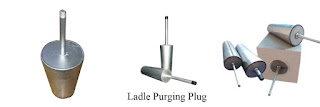Analysis of causes of transverse cracks in tundish working lining
The tundish
is an important intermediate equipment that connects steelmaking and
continuous casting in the steelmaking production process. It can store
molten steel, distribute molten steel, ensure continuous pouring, reduce
pressure and stabilize flow, promote the floating and removal of
non-metallic inclusions, and uniform molten steel composition and
temperature. And many other metallurgical functions. The normal
operation of the tundish directly affects the antegrade of the
continuous casting process and the final quality of the slab. However,
due to the particularity of the working conditions of the tundish, not
only the high-temperature molten metal is constantly eroded, but also
experienced a sudden drop in temperature, which has a great impact on
the life of the tundish.
Cause Analysis
1.The difference in the composition of different dry ingredients
The two dry aggregates use different grades of sintered magnesia or fused magnesia. When baking at low temperature, the dry material of the working layer shrinks, the porosity increases significantly, the volume density decreases, and the compressive strength decreases. The two kinds of dry materials shrink to different degrees after heat treatment, which will affect the inner lining of the tundish to different degrees.
2.The baking temperature is too high
The factors affecting the collapse and spalling of the dry material in the tundish, in addition to the dry material itself, the construction status on site is also a key factor. It is conventionally required that the tundish filling material needs to be naturally cooled for 3 to 4 hours after turning the package, and the filling construction should be carried out below 120 ℃. The dry material will not solidify at this temperature and maintain fluidity. In actual construction, due to the slow cooling rate, the temperature of the tundish is still 150°C during filling. Too high temperature will easily cause uneven hardening reaction in the inner layer or contact layer, resulting in internal cracks, while baking During the process, the cracks spread to the surface.
3. The combination of different dry materials
The dry material of the tundish slag line and the dry material of the wall are two kinds of dry materials of different materials. The thermal decomposition rate of the organic binder of the two dry materials is different, and the speed of the strength loss and the final carbonization residual strength are also different. If the stress release of the two dry materials is not considered, the probability of cracks will increase. In addition, the contact area of different dry materials is too small to increase the possibility of cracks.
Article Source:The application of corundum refractory castable
Company name :Luoyang Wanhao New Material Co., Ltd.
More Refractory Products: http://www.wanhaorefractory.com/en/product.html
Website: http://www.wanhaorefractory.com/


评论
发表评论